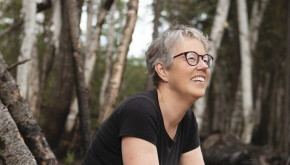
By Gloria Erickson, as told to Ashley McFarland. Reposted from Minnesota Women’s Press. See the original article here.
Photo: Gloria Erickson at the site of a controlled burn near Ely. Photo by Sarah Whiting.
These days, you can find me at the “end of the road” just outside of Ely, which is a far cry from the bustling cities where I chased my love of theater and worked as an interior designer. After nearly 20 years of that fast pace, I found myself longing for the solitude of the Northwoods that I fell in love with while studying at the University of Minnesota Duluth. Settling up north came with a host of challenges: securing work in a small community, battling extreme weather, and the maintenance that comes with living in the woods.
I quickly learned that the dense forest was an unhealthy landscape cluttered with vegetation due to a century of fire suppression. The forest longed for the natural process of fire that has shaped Minnesota’s Northwoods over time. In fact, the boreal forests of northern Minnesota are categorized as a fire-dependent ecosystem — meaning they have evolved with fire as an essential element of species renewal and diversity.
Ironically, the practices that have kept fire off the landscape are now creating an environment primed for catastrophic wildfire to occur.
For millennia, Indigenous people practiced low-intensity burns to support moose habitat and blueberries.
Nearly a century ago, however, federal land management across the landscape shifted from seeing fire as a tool towards viewing it as a destructive force that threatens property, public safety, and timber resources. This suppression mindset has led to a degradation of forest health. Ironically, the practices that have kept fire off the landscape are now creating an environment primed for catastrophic wildfire to occur.
Minnesota and Wildfires
Minnesota wildfire history is often overshadowed by the larger, more frequent events that have become synonymous with western forest fires that we see in California, Washington, and Colorado. Minnesota has, however, experienced devastating wildfire events, including the Hinckley Fire in 1894 that consumed 350,000 acres and killed over 400 residents, and the Pagami Creek Fire of 2011 that ravaged nearly 100,000 acres just east of Ely.
I was in Ely during the Pagami Creek Fire, which was an unpredictable and swift-moving fire that created unprecedented conditions. Although smaller, the Highway 1 Fire, located just south of Ely in 2012, led to wide-scale evacuations, myself included. With a slight change in conditions, that fire could have overtaken the community.
Conditions in our forests are at a tipping point. It is only a question of when a large-scale fire will strike again.
The suppression of fire has jeopardized the well-being of the forest and produced an unhealthy abundance of vegetation that would have been otherwise thinned out through natural, small fires. Increasing tree density has led to disease and insect pressures; specifically, the eastern spruce budworm defoliates and kills vast acreages of balsam fir and spruce each year in Minnesota. A similar occurrence with the mountain pine beetle is what led to such devastating events in the western U.S. The dead and dying trees in the forest, coupled with periods of extreme drought, resulted in an unsustainable fuel load that is prime for wildfire activity.
An increase in extreme weather events is also impacting our forests. High wind events, called derechos, hammered the region in 1999 and 2016, with their effects still being felt today. My first summer in Ely corresponded with the 1999 disaster. At the time, I was living in a tent. The derecho produced straight-line winds of up to 100 mph. Miraculously, myself and my tent survived that storm, unlike the over 500,000 acres of uprooted and toppled trees in its path, which included portions of the Boundary Waters Canoe Area Wilderness.
By the time of the 2016 derecho, I had thankfully turned my tent in for a home, but a tree narrowly missed me as it toppled onto my sleeping porch. I had over 100 trees come down on my property during that storm — a mess I am still working on untangling.
Living With Fire
Thanks to the wonderful community I now call home, we have made significant progress. I found employment with Dovetail Partners, an environmental nonprofit organization, as their community wildfire project manager. I now channel my passion into caring for the woods and helping my adopted Northwoods communities be more wildfire resilient. We provide resources and teach residents how to live safely with fire.
Our boreal forest is a mosaic of multiple land ownerships; federal, state, county, municipal, tribal, nonprofit, and private. Wildfire does not recognize these boundaries. We all have a part to play in restoring the health of our forest and learning to live with wildfire. Collaboration, creative thinking, strategic planning, and implementation across boundaries are key to restoring the health of our forests for future generations.
Practices include removing excess vegetation, especially that which is dead or dying, from property; ensuring property can be safely accessed by emergency personnel and evacuated in the case of a fire; and promoting restoration in our forests, including the reintroduction of safe fire.
Building relationships and diverse partnerships, honoring local and scientific knowledge holders, and working collaboratively — all are keys to success.
If you want to know more about what you can do to support forest restoration and wildfire resiliency, contact Gloria Erickson at [email protected]

